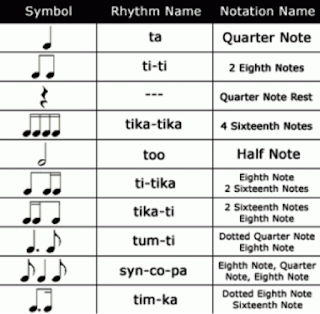Basic Music Theory - 1st Post - Notes, Rests, and Note Particulars
It is really
important for a singer, even an amazingly gifted singer, to understand basic
Music Theory. That doesn’t mean you
have to be any kind of virtuoso or study music theory for dozens of years but
it does mean you need to study some fundamental or elemental aspects of
theoretical concepts. Your first “basic”
lesson is below. Stay tuned for more
“installments” in the future. Here goes:
•
NOTES AND
RESTS - Melodies in music are represented through patterns of “Notes”
and “Rests”. Here is a chart of the most
common types of Notes and Rests:
The Quarter Note is, by far, the most common type of Note and
Rest but each of these notes and rests are important, universal, and
frequently-occurring. You DO need to
know, however, that the values you see here CAN change, depending on the Time
Signature (see the next post that covers Time Signatures) of the entire
song. The values shown here are
applicable for any Time Signature with a “4” in the bottom, such as 2/4, 3/4,
4/4, or 6/4. However, when the bottom
number changes to an “8:, the other values (Quarter, Half, and Whole Notes)
would be DOUBLED, such as 3/8 or 6/8.
This means an Eighth Note will get 1 count. When the signature’s bottom number is a “2”,
a half note gets one count, and the values shown here would be cut by
half. A “16” on the bottom means a
Sixteenth Note gets one count and all other values listed above will be
QUADRUPLED or multiplied by 4. The “Dotted”
Notes in the lower chart do NOT have corresponding Rests. The “dot” added to a note causes the note’s
value to increase by half again, such as a Dotted Quarter Not equaling 1 1/2
counts; a Dotted Half Note equaling 3 counts; a Dotted Eighth Note equaling 3/4
of a count. The combination of the pitch
of the notes, and the rhythmic value of each note and rest, creates a musical
melody.
NOTE
BEAMING - A “beam” is a horizontal connecting line over the top of or
below a group of notes that is to be played as a rhythmic set. The beam does not change the value of each
individual note. The Beam replaces the
Flag found on individual Notes. One Beam
is used for Eighth Notes; Two Beams are used for Sixteenth Notes. Beams are used to avoid the “clutter” of all
the Flags when a group of Notes are involved.
See below:
First Row - Eighth Notes; Second Row - Sixteenth Notes; Third
Row - Eighth & Sixteenth Notes
NOTE STEM
DIRECTION - Another helpful “clerical” detail in Music Theory/Composition
is the direction of the Notes on a Staff.
You might notice that some of the Note Stems point upward and some point
down. The main reason for this is to
allow more space on any given page for more music. Stems on Notes that occur ON or BELOW the
middle line of the Staff are drawn upward.
Notes written ABOVE the middle line will have stems pointing downward.
Okay, so this is already a lot of information to digest and we
want to take our time going through all these massively huge sections of Music
Theory. Notes and Rests are an important
brick in the foundation of understanding reading music. Thanks for going on this adventure with
me. Please send me any questions,
comments, or suggestions for future blog posts.
Thanks again for reading! For any
questions about my lessons, or me check out my website at www.SingitForward.net.
See you next post! Sing it
forward!





Thank you, just for clarity; are the notes with stems pointing upward for soprano and the stems pointing down for Alto?
ReplyDeleteThankyou so very much the notes and symbols are very useful.
ReplyDeleteI like to sing because my voice sound beautiful and i love it
ReplyDeleteur weird
Delete